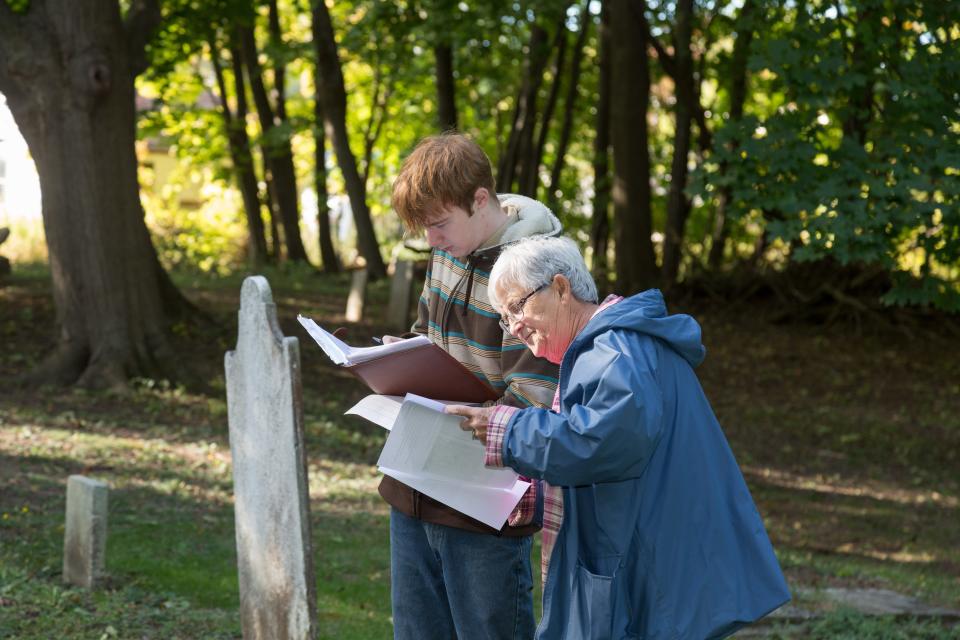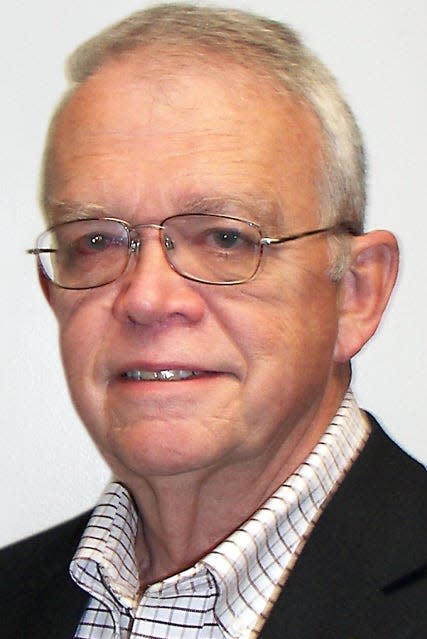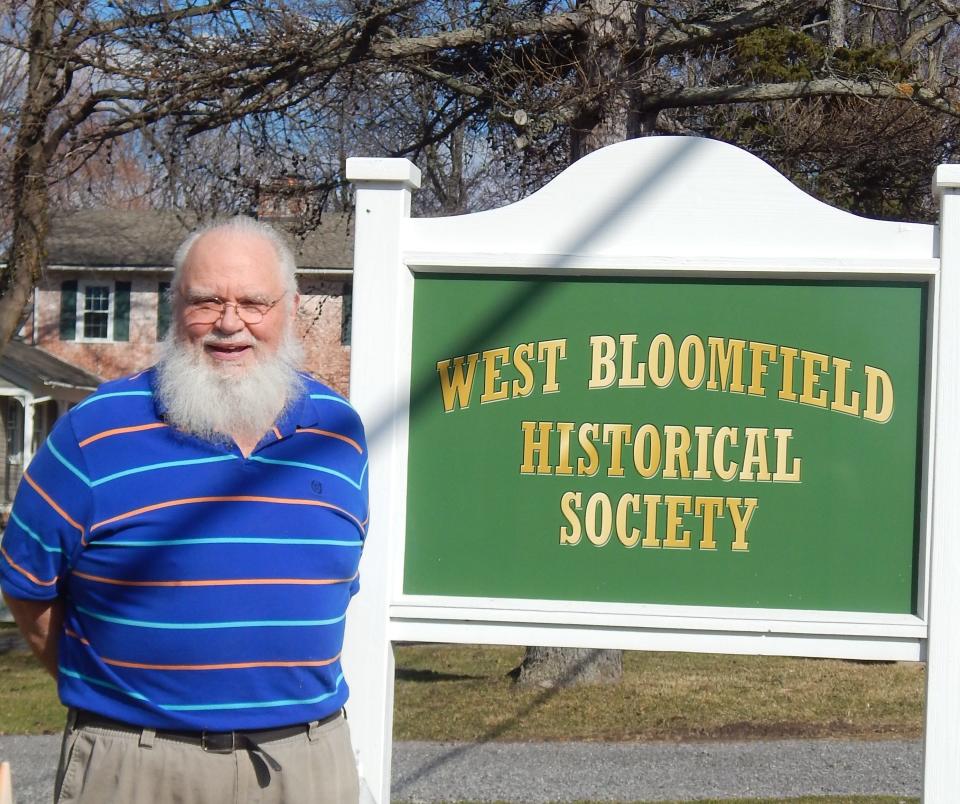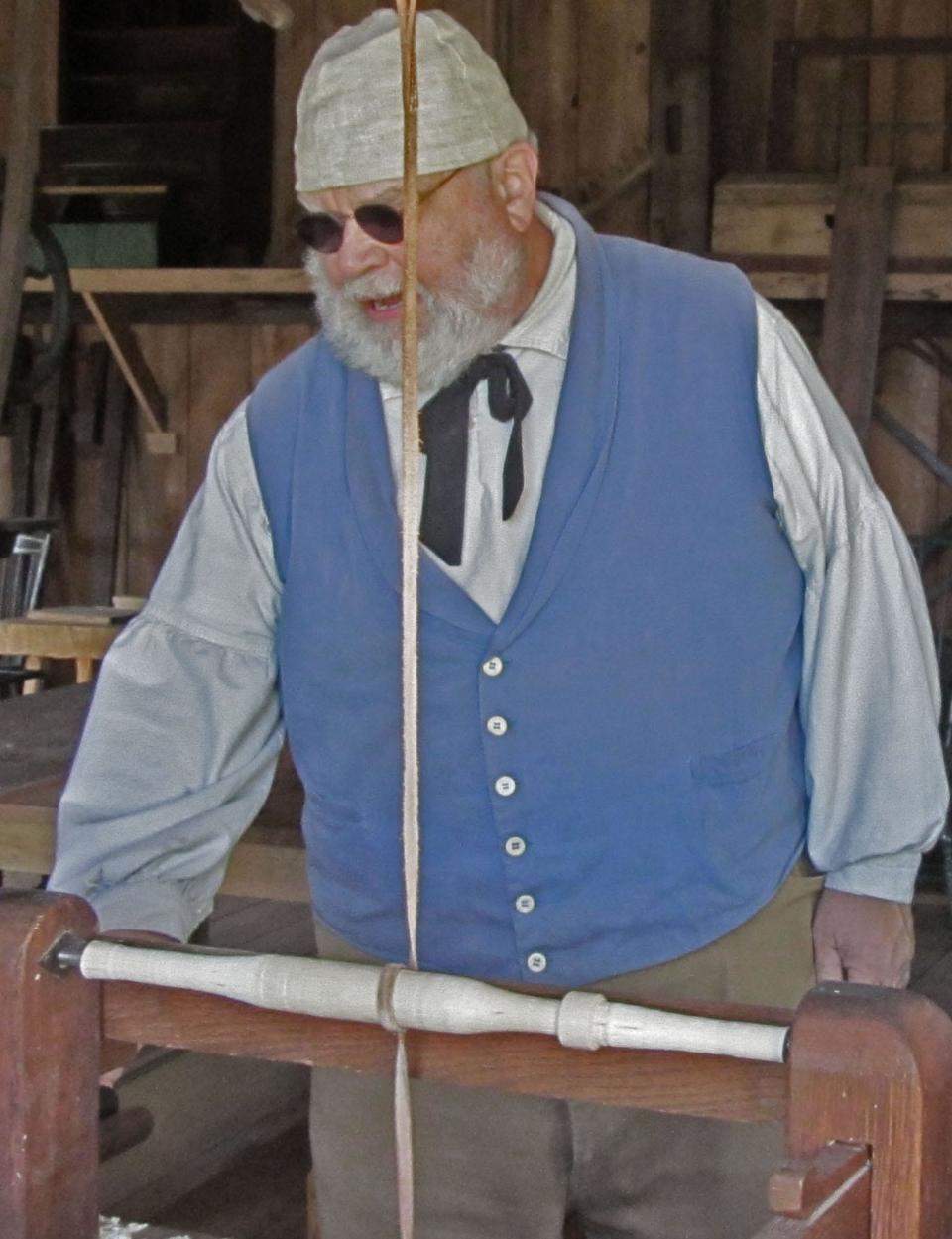West Bloomfield Town Historian Pat Talley is retiring after 12 years
WEST BLOOMFIELD — During her tenure as West Bloomfield’s town historian, Pat Talley was contacted by people from all over the country seeking information about their families' relatives.
Talley, now retiring after 12 years on the job, has become familiar with the final resting spots of many former town residents in West Bloomfield’s four cemeteries.
“Pat took a great interest in the people who made inquiries, sometimes even developing friendships through correspondence,” said Suzanne Washburn, president of the West Bloomfield Historical Society. “She would provide information about an ancestor’s gravesite to someone, and then personally escort the descendant to the cemetery.”

Talley leaves big shoes to fill for her replacement, Victor native Mike Borgeest.
Some of her accomplishments as historian include compiling extensive files on residents who served in the military and are buried in town cemeteries.
“I feel people that fought to make our country free need to be respected,” said Talley. She learned more about General Amos Hall, the only veteran in West Bloomfield involved in both the Revolutionary War (1775-1783) and the War of 1812. Buried in the town’s Pioneer Cemetery, Hall held several public offices and took the first census of western New York in 1790.
Talley’s personal attention resulted in a memorable response from Candis Hall Aaron, a descendant of Hall, one of the town’s earliest settlers. In the Rural Cemetery near the Historical Society, Talley pointed out the gravesite of the woman’s grandmother for whom she was named.
“When I showed her the grave and marker, she got down on her knees and cried,” said Talley.
History of Ontario County: Before West Bloomfield: — the town's early years
More: 'Blood, Sweat and Tears' lauded in preserving Ontario County's past
As a member of the White family, longtime Bloomfield farmers, Talley’s ties to local history run deep. Her great-grandfather, Charles R. White, became an adviser on agriculture and finance to Franklin D. Roosevelt when FDR was New York’s governor. White was responsible for changing the name of the hamlet of Millers Corners to Ionia, said Talley.
Talley will be thanked for her years of dedicated service to the town and the Historical Society on April 19. The public is invited to the West Bloomfield Historical Society’s first event since the start of the pandemic. Beginning at 7 p.m., the evening includes what is described as “refreshed exhibits,” including some discoveries made during the past two years by the society’s Collection Committee.
Local historians
Ontario County Historian Preston Pierce said he doesn't have any record of the date for the first historian for any town in Ontario County, but the authorization for town historians rests in a 1919 law passed by the state legislature.
“A few towns had historians, official or unofficial, prior to that time," Pierce said. "In most communities we know of appointments at least from the 1950s and 1960s.”

Pierce said that like today, 1919 was a troubled time that marked great changes in population, economy, politics, and society.
“The brutal fighting in what was then ‘the war to end all wars’ had just concluded," Pierce said. "There was a great public desire to conserve information and artifacts about our past from which we could draw inspiration in the future. That became the role of the town historian. It still is — and in times not unlike 1919 in many ways.”
The West Bloomfield Town Board voted to expend $10 to appoint a historian beginning in the 1940s, according to old records unearthed by former Town Clerk Mary Grundman. The first historian was likely Rena Parrish.
Recently, following a search through decades of Town Board annual organizational meetings, current West Bloomfield Town Clerk Brenda Giglia said those from the 1940s and 1950s have not yielded the identities of all town historians. But Historical Society documents found by Talley reveal that Parrish, longtime postmistress of the hamlet of Ionia, was historian as early as 1944. Later on, Gladys Shackleton or her sister, Beatrice, both teachers, replaced Parrish for a time. Giglia located the following names of their successors: Helen Shetler, 1964-1978; Jill Smith, 1979-1984; Kurt Kleindeinst, 1985-2008; Sandra Bortle Schlenker, 2008-2009; and Pat White Talley, 2010-2021. Mike Borgeest was appointed town historian in 2022.
Talley had strong connections with two past town historians — Rena Parrish, her great-aunt, and Sandra Bortle Schlenker. As a teenager Talley did typing for Parrish, a mentor who stimulated her interest in history.
“She talked history and kept track of everything in town,” said Talley.
Schlenker, Talley’s close friend since their school days together in Bloomfield, was founder of the West Bloomfield Historical Society and author of several local history books. Talley has also written books — a family cookbook and a genealogy of the Paul family with East Bloomfield native Dr. John Paul, who retired to Canandaigua. Talley credited Schlenker for piquing her interest in genealogy.
Talley’s last project as historian was an inventory of the Historical Society collection — something not done previously.
“The society members waited to move things around until after I finished the inventory,” she said. It took nearly two years and was done between her other duties.
Society President Washburn said Talley also established and made generous donations to two funds in memory of her late husband: the Dwight Talley Memorial Conservation Fund to support the collection and the Dwight Talley Memorial Fund to support heating costs (this protected the collection during the pandemic by enabling the building to be kept at a consistent temperature all year).
“Pat has served her town well,” said County Historian Pierce. “Her work has been a great example of what the authors of that 1919 law had in mind. While I will miss her contributions, I look forward to seeing her work continued by her successor. We have all, the whole county, been fortunate to have Pat's work and public service.”
What advice would Talley offer to anyone in the historian position in the future?
“Be well-read and be able to put yourself in the time and place you are researching," Talley said.
The biggest challenge: “Make sure your facts are correct.”

Meet the new historian
Victor native Mike Borgeest, 68, has lived in the area for 60-plus years. The Rochester Institute of Technology graduate is retired from the insurance industry where he served over 30 years as a senior claims adjuster handling auto and property, specializing in heavy equipment claims. He was on the company's National Catastrophe Team settling claims from tornadoes to mid-western hailstorms to the Northridge, California earthquake.
Early on in life Borgeest discovered woodworking.
“My father has always been a hands-on, up-for-any-challenge type," Borgeest said. "As a kid I enjoyed spending time with him building such things as a family camping trailer and later on took on many, many home improvement projects.”
When only 13, Borgeest became fascinated by the brass movement of an old clock that resulted in his accumulating and repairing over 500 such antique clocks.
While he lost interest in clocks, his woodworking passion never subsided and he attended a school in New Hampshire that taught how to build Windsor chairs using period-correct hand tools.

“The Windsor Institute became my go-to place once and often twice a year for one-week sessions,” Borgeest said. Some 15 years after beginning that journey he reached the designation of the 19th Duke of Windsor, at which point he assisted in the teaching process. To date he has built some 50-plus Windsor chairs of multiple types and demonstrates the craft of building Windsor chairs with period hand tools at the Genesee Country Village and Museum in Mumford, Monroe County.
Borgeest is currently restoring the 1803 Watrous Peck House.
”I purchased the home some 10 years ago and was successful in having it placed on the National and New York State historic registers. My restoration plan was to be complete in five years," Borgeest said. "However, I'm beginning my 11th year of that five-year plan.”
The latest portion completed was the removal of six incorrect windows. The restoration involved sourcing period 12-over-12 window sash and hand building window casings. All of the first-floor windows are now period correct.
What are Borgeest’s goals?
Public awareness will be the new historian’s focus.
“History has a way of being lost and or falling to an incorrect telling of the facts," Borgeest said. "And many people have little knowledge of the importance of local history. Much like government, all history is local.”
In restoring his own home, he learned how the Erie Canal changed the physical appearance of local homes.
“Most of the area’s older surviving homes have an ‘ell’ addition,” said Borgeest. In architecture, an ell is a wing of a building perpendicular to the length of the main portion.
“That addition was most often a specific response to improve the home's open fireplace method of cooking," Borgeest said. "The Erie Canal brought so many unseen items to the then frontier of the Finger Lakes — one of the most influential being the cast iron stove. And that large robust stove needed a spacious room. So was born the ell. With the new stove, the new space became the ‘modern’ kitchen of the 1830s to 1850s and often far beyond.”
These days, in his spare time Borgeest helps at the West Bloomfield Historical Society on such projects as a new handicap-accessible ramp.
“And just to keep things interesting, Sue Washburn and I have undertaken the revival of the Community Focus,” said Borgeest. The town newsletter, with a distribution of approximately 1,800, had fallen into non-publication a few years back.
This article originally appeared on MPNnow: West Bloomfield Town Historian Pat Talley is retiring after 12 years

